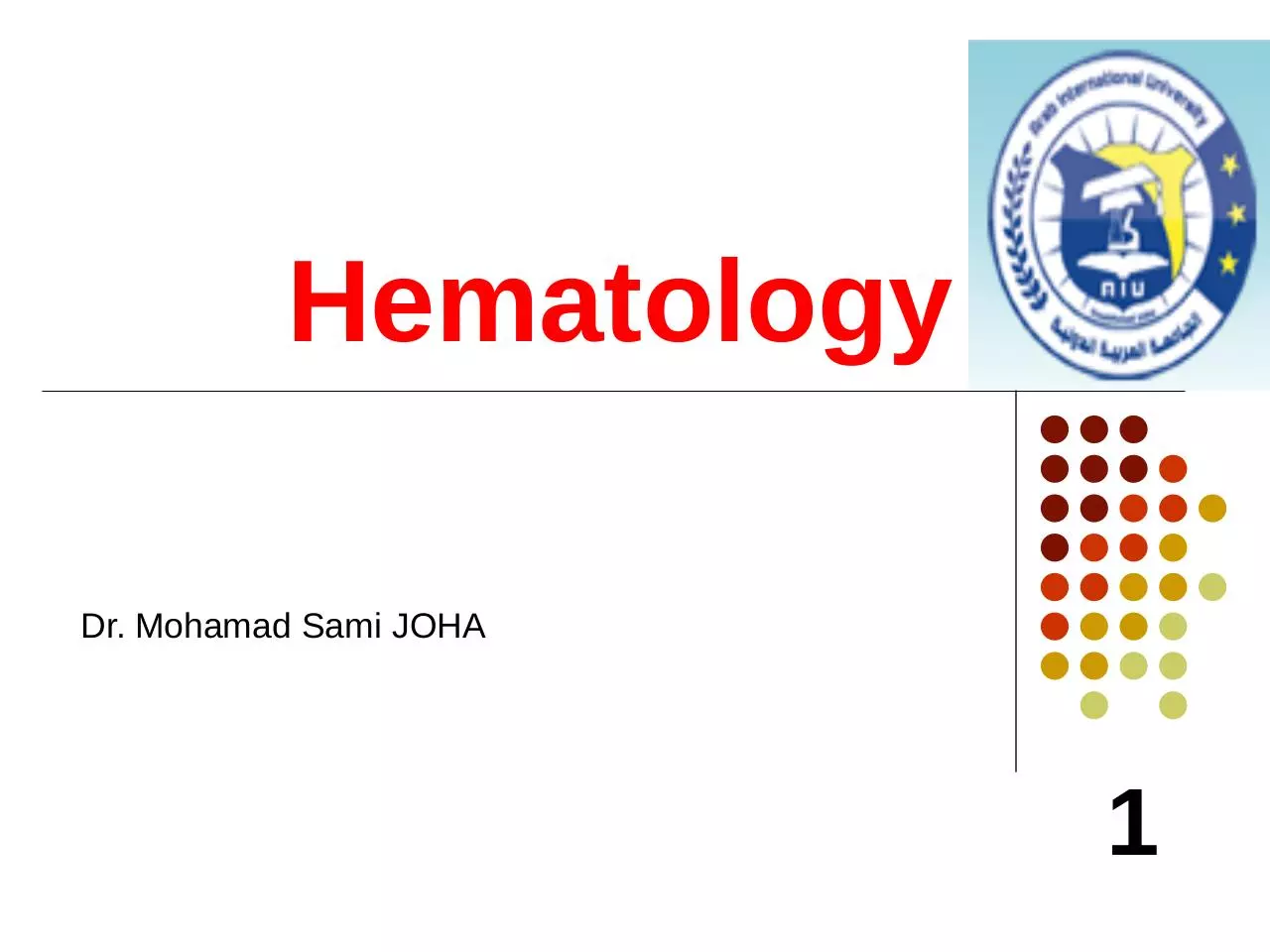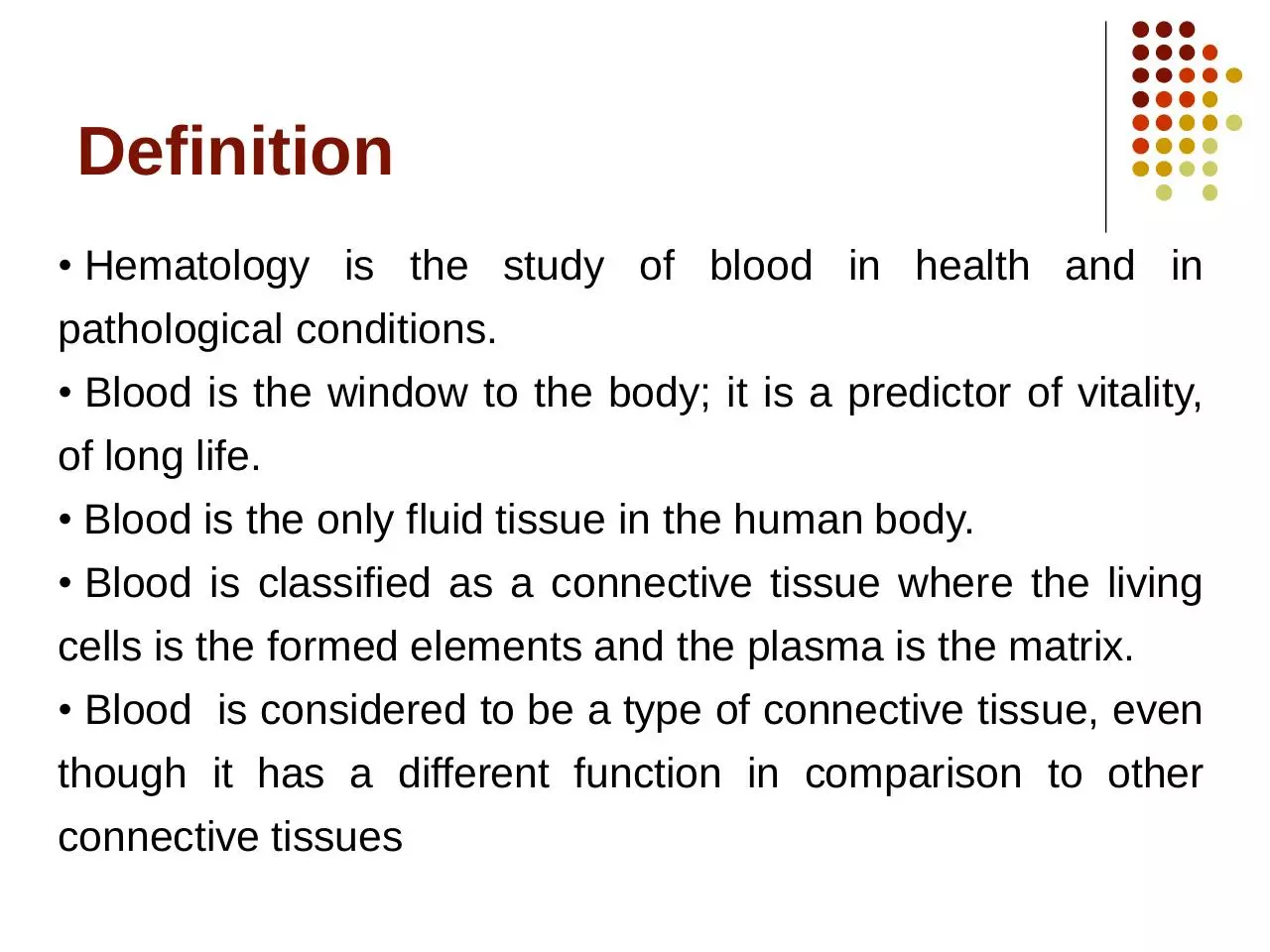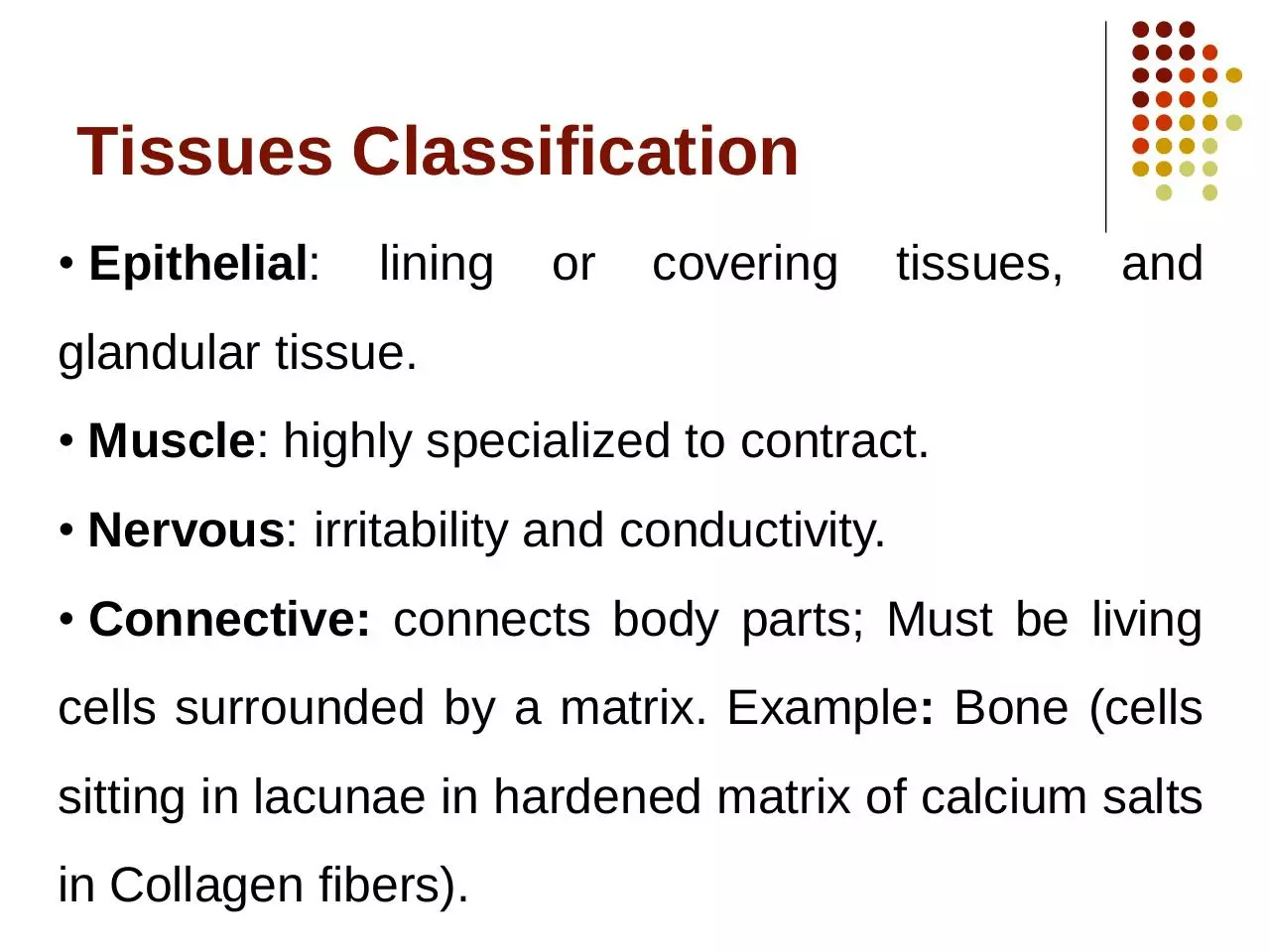AIU T1 (PDF)
File information
Title: BLOOD
Author: Sami
This PDF 1.5 document has been generated by Microsoft® Office PowerPoint® 2007, and has been sent on pdf-archive.com on 17/05/2013 at 10:46, from IP address 85.237.x.x.
The current document download page has been viewed 1176 times.
File size: 833.31 KB (22 pages).
Privacy: public file





File preview
Hematology
Dr. Mohamad Sami JOHA
1
Definition
• Hematology is the study of blood in health and in
pathological conditions.
• Blood is the window to the body; it is a predictor of vitality,
of long life.
• Blood is the only fluid tissue in the human body.
• Blood is classified as a connective tissue where the living
cells is the formed elements and the plasma is the matrix.
• Blood is considered to be a type of connective tissue, even
though it has a different function in comparison to other
connective tissues
Tissues Classification
• Epithelial:
lining
or
covering
tissues,
and
glandular tissue.
• Muscle: highly specialized to contract.
• Nervous: irritability and conductivity.
• Connective: connects body parts; Must be living
cells surrounded by a matrix. Example: Bone (cells
sitting in lacunae in hardened matrix of calcium salts
in Collagen fibers).
History
• In 1628, William Harvey discovered that blood circulated
through the body.
• Different blood types were recognized in 1875, but it wasn't
until 1901 that Karl Landsteiner named and standardized the
groups.
• In 1940, Landsteiner also discovered the rhesus factor in
blood, labeling it Rh+ if the antigen was present in the red
blood cells and Rh- if not.
•Today, blood typing also includes different types of enzymes
and proteins that perform specific activities in the body,
which helps to individualize the blood.
Characteristics of Blood
• Color range: oxygen-rich blood is scarlet red, while oxygenpoor blood is dull red.
•Thicker (more viscous) than water and flows more slowly
than water.
• PH must remain between 7.35–7.45.
• Blood temperature is slightly higher than body temperature
• 8 % of total body weight
• Blood volume (70 ml/kg of body weight):
5 to 6 liters in average male
4 to 5 liters in average female
hormonal negative feedback systems maintain constant blood
volume and osmotic pressure
Microscopic
Views
Fish Blood
Bird Blood
Horse Blood
Frog Blood
Cat Blood
Dog Blood
Human Blood
Snake Blood
Blood Functions
• Transportation of dissolved gases, nutrients, hormones,
and metabolic wastes.
• Regulation of pH and electrolyte.
• Restriction of fluid loss through damaged vessels and other
injury sites.
• Defense against toxins and pathogens.
• Stabilization of body temperature: water is a high heat
capacity, thermal conductivity.
Circulation of Blood
• Blood vessels, along with the heart, are responsible for the
circulation of blood throughout the body.
• The human vascular system consists of approximately
70,000 of blood vessels.
• Coronary circulation provides blood supply to the heart.
• Pulmonary circulation occurs when blood that has been
used by the cells of the body is returned to the heart and
transported to the lungs for gas exchange.
• Systemic circulation.
Circulation of Blood
Arteries carry blood away from the heart and
veins carry blood toward the heart. The
capillaries are exchange vessels located
between the arterial and venous systems.
Composition of Blood
Composition of Blood
Composition of Blood
Plasma = 55% of
whole blood
A. Platelets
“Buffy coat”
<1%
Cellular
elements
(45%)
B. WBCs
Red blood cells =
45% of whole blood
I-Plasma: Proteins
• 55% plasma: 8% dissolved substances (sugars,
amino acids, lipids & vitamins), ions, dissolved
gases, hormones.
7% of dissolved substances are plasma proteins:
provide a role in balancing osmotic pressure and
water flow between the blood and extracellular
fluid/tissues.
There are more than 200 proteins in plasma. Most
abundant plasma proteins: albumin (4-5 g/100 mL),
globulins (~1 g/100 mL), fibrinogen (0.2-0.4g/100
mL).
Functions of Plasma Proteins
• Maintenance of Colloid osmotic pressure, pH and
electrolyte balance.
• Transport of ions, fatty acids, steroids, hormones
etc.
• Nutritional source of amino acids for tissues.
• Hemostasis (coagulation proteins).
• Prevention of thrombosis (anticoagulant proteins).
• Defense against infection (antibodies, complement
proteins).
Plasma Proteins: Albumin
• MW 66 kDa
• Single chain composed by 580 amino acids.
• Dimensions: Heart shaped molecule.
• Synthesis:
Mainly liver cells then exported.
Assembly time on ribosome ~ 1-2 min.
t1/2 in circulation :19 days.
14 g lost per day.
0.4 mg synthesized per hour per g of liver
Need liver of approximately 1.5 kg in weight to
maintain.
Plasma Proteins: Albumin
• Functions
“Colloid” osmotic pressure of blood is 80% due
to albumin
relatively low molecular weight
regulates water distribution
Transport of fatty acids: Liver to tissues.
Source of amino acids for tissue cells
(pinocytosis).
Plasma Proteins: g-Globulins
• 20-35% of plasma proteins
• “g” refers to electrophoretic mobility.
• Represents a group of proteins of variable
structure (Immunoglobulins).
• Main
functional
task
is
immunochemical:
antibodies combine with specific antigens.
Plasma Proteins: Fibrinogen
• MW 340 KDa.
• Produced by liver and Consists of two identical
subunits which are linked by disulphide bonds.
• Marker of inflammation.
• Function: Blood coagulation.
Thrombin
Fibrinogen
Fibrin
Plasmin
Fibrin
Degradation (FDP)
Plasma Proteins: Other Proteins
• Ceruloplasmin: binds copper, storage.
• Corticosteroid-binding globulin: binds cortisol.
• Haptoglobulin: binds extracellular hemoglobin.
• Lipoproteins: bind cholesterol and fatty acids.
• Retinol-binding protein: binds vitamin A.
• Sex hormone-binding globulin: binds estradiol,
testosterone.
• Transferrin: transports iron.
Plasma: Other Solutes
• Electrolytes:
normal
extracellular
fluid
ion
composition essential for vital cellular activities.
Examples: Na, K, Cl.
• Organic nutrients: used for ATP production, growth
and maintenance of cells. Examples: fatty acids,
glucose and amino acids.
• Organic wastes: carried to sites of breakdown or
excretion. Examples: urea and bilirubin
II- Cellular (formed) elements
• 45% of total volume.
• Erythrocytes (RBCs): 99.9%
• Platelets
• Leukocytes (WBCs)
A. Granulocytes:
Neutrophils
Eosinophils
Basophils
B. Agranulocytes:
Lymphocytes
Monocytes
II- Cellular (formed) elements
Download AIU T1
AIU T1.pdf (PDF, 833.31 KB)
Download PDF
Share this file on social networks
Link to this page
Permanent link
Use the permanent link to the download page to share your document on Facebook, Twitter, LinkedIn, or directly with a contact by e-Mail, Messenger, Whatsapp, Line..
Short link
Use the short link to share your document on Twitter or by text message (SMS)
HTML Code
Copy the following HTML code to share your document on a Website or Blog
QR Code to this page

This file has been shared publicly by a user of PDF Archive.
Document ID: 0000105523.